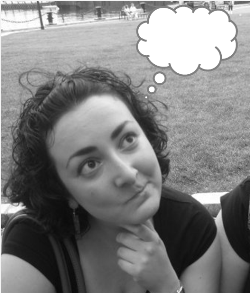 There's nothing like a great conference to really get lots of thoughts and ideas jumping around in your head, just waiting for a blog post to flush them out. Yesterday I drove down to Randolph, MA for Geek Girl Camp Boston to talk to women about how to use inbound marketing and, specifically, Facebook, for business and afterwards I was so energized with blog post ideas about marketing and Facebook and social media newbies.
There's nothing like a great conference to really get lots of thoughts and ideas jumping around in your head, just waiting for a blog post to flush them out. Yesterday I drove down to Randolph, MA for Geek Girl Camp Boston to talk to women about how to use inbound marketing and, specifically, Facebook, for business and afterwards I was so energized with blog post ideas about marketing and Facebook and social media newbies.
But that's not really what this blog post is about. I'm actually pretty new to the conference speaker role, and I was excited to get some experience at this event. Feedback was great (thank you all!), but of course I want to improve. I'll be the first to admit that I have a tendency to be a bit wordy and confusing when I try to explain things that I know too much about. I definitely fall victim to the Curse of Knowledge and need to work on better explaining things I know a lot about, like Facebook.
So when I got home last night, I pulled out (one of the four books I'm currently reading) Made to Stick to pick up where I left off (months ago... I really need to focus on one book at a time). Made to Stick has been one of the best business books I have ever read, really helping me with this Curse of Knowledge that I so easily fall victim to. Something that occurred to me - both in observing the authors' writing style and also the section specifically on Concrete ideas being "sticky" - was that concrete examples or case studies can be a huge help in delivering your idea in an effective way while also overcoming the Curse! By using real life examples of what you're explaining, a reader or listener can more easily remember your story. Also, by using case studies, you paint a picture that is worth a thousand words - your audience can fully experience what you're talking about, draw their own conclusions, and all at the same time, you make a lot more sense by not being so abstract.
Uh oh, I'm falling victim to it again. I'm being too abstract and not using concrete examples! So let's try this again.
In my presentation at GGC, I spent a lot of time talking about the news feed, about business Pages, about Facebook applications. Sure, I was giving step-by-step instructions for setting up a Page, but I still got a lot of questions like, "What if I don't want my clients to see my friends' kids' photos?" or "Should I use my real name?" -- questions more easily answered by just jumping in and seeing how Facebook works from a user's perspective.
Here's what I could have done: logged in to Facebook. Shown the news feed. Look! My friend Dan posted a link to his latest blog post. Mike uploaded a video of his son. Ashley became a fan of Flight of the Conchords. From there, we could go look at the Flight of the Conchords Page on Facebook. We could look at Ashley's profile, that shows she's a fan of that Page. And we remember that her action of becoming a fan actually showed up when I logged in. That's pretty cool.
That's one idea. By making it a lot more concrete, people can see exactly what Facebook is and how it works and will (hopefully) be better able to jump in using it.
What I especially like about the case study approach is that I can still allow myself to be wordy... But in this case, my words are used to describe a story. They add color and texture, and at the end, the listener can get a fuller experience of the picture, instead of me throwing a thousand words at them to describe the picture. I'm hoping from now on I'll try to paint more pictures... and not write any more dissertations.
